Production and Mechanical Characterization of Graphene Micro-Ribbons
Abstract
1. Introduction
2. Materials and Methods
3. Results and Discussion
CVD Graphene Micro-Ribbons
4. Conclusions
Supplementary Materials
Author Contributions
Funding
Acknowledgments
Conflicts of Interest
References
- Geim, A.K.; Novoselov, K.S. The rise of graphene. Nat. Mater. 2007, 6, 183–191. [Google Scholar] [CrossRef] [PubMed]
- Bonaccorso, F.; Sun, Z.; Hasan, T.; Ferrari, A.C. Graphene photonics and optoelectronics. Nat. Photonics 2010, 4, 611–622. [Google Scholar] [CrossRef]
- Avouris, P.; Dimitrakopoulos, C. Graphene: Synthesis and applications. Mater. Today 2012, 15, 86–97. [Google Scholar] [CrossRef]
- Soldano, C.; Mahmood, A.; Dujardin, E. Production, properties and potential of graphene. Carbon 2010, 48, 2127–2150. [Google Scholar] [CrossRef]
- Wang, D.B.; Tian, H.; Yang, Y.; Xie, D.; Ren, T.L.; Zhang, Y.G. Scalable and Direct Growth of Graphene Micro Ribbons on Dielectric Substrates. Sci. Rep. 2013, 3, 1348. [Google Scholar] [CrossRef]
- Kalita, G.; Qi, L.T.; Namba, Y.; Wakita, K.; Umeno, M. Femtosecond laser induced micropatterning of graphene film. Mater. Lett. 2011, 65, 1569–1572. [Google Scholar] [CrossRef]
- Tian, H.; Shu, Y.; Cui, Y.L.; Mi, W.T.; Yang, Y.; Xie, D.; Ren, T.L. Scalable fabrication of high-performance and flexible graphene strain sensors. Nanoscale 2014, 6, 699–705. [Google Scholar] [CrossRef] [PubMed]
- Salehi-Khojin, A.; Estrada, D.; Lin, K.Y.; Bae, M.H.; Xiong, F.; Pop, E.; Masel, R.I. Polycrystalline Graphene Ribbons as Chemiresistors. Adv. Mater. 2012, 24, 53–57. [Google Scholar] [CrossRef] [PubMed]
- Niu, Z.Q.; Zhang, L.; Liu, L.; Zhu, B.W.; Dong, H.B.; Chen, X.D. All-Solid-State Flexible Ultrathin Micro-Supercapacitors Based on Graphene. Adv. Mater. 2013, 25, 4035–4042. [Google Scholar] [CrossRef] [PubMed]
- Ju, L.; Geng, B.; Horng, J.; Girit, C.; Martin, M.; Hao, Z.; Bechtel, H.A.; Liang, X.; Zettl, A.; Shen, Y.R.; et al. Graphene plasmonics for tunable terahertz metamaterials. Nat. Nanotechnol. 2011, 6, 630–634. [Google Scholar] [CrossRef]
- Lee, C.; Wei, X.D.; Kysar, J.W.; Hone, J. Measurement of the elastic properties and intrinsic strength of monolayer graphene. Science 2008, 321, 385–388. [Google Scholar] [CrossRef] [PubMed]
- Gao, Y.W.; Hao, P. Mechanical properties of monolayer graphene under tensile and compressive loading. Physica E 2009, 41, 1561–1566. [Google Scholar] [CrossRef]
- Androulidakis, C.; Koukaras, E.N.; Carbone, M.G.P.; Hadjinicolaou, M.; Galiotis, C. Wrinkling formation in simply-supported graphenes under tension and compression loadings. Nanoscale 2017, 9, 18180–18188. [Google Scholar] [CrossRef] [PubMed]
- Mohiuddin, T.M.G.; Lombardo, A.; Nair, R.R.; Bonetti, A.; Savini, G.; Jalil, R.; Bonini, N.; Basko, D.M.; Galiotis, C.; Marzari, N.; et al. Uniaxial strain in graphene by Raman spectroscopy: G peak splitting, Gruneisen parameters, and sample orientation. Phys. Rev. B 2009, 79, 205433. [Google Scholar] [CrossRef]
- Frank, O.; Tsoukleri, G.; Riaz, I.; Papagelis, K.; Parthenios, J.; Ferrari, A.C.; Geim, A.K.; Novoselov, K.S.; Galiotis, C. Development of a universal stress sensor for graphene and carbon fibres. Nat. Commun. 2011, 2, 255. [Google Scholar] [CrossRef]
- Frank, O.; Tsoukleri, G.; Parthenios, J.; Papagelis, K.; Riaz, I.; Jalil, R.; Novoselov, K.S.; Galiotis, C. Compression Behavior of Single-Layer Graphenes. ACS Nano 2010, 4, 3131–3138. [Google Scholar] [CrossRef] [PubMed]
- Tsoukleri, G.; Parthenios, J.; Papagelis, K.; Jalil, R.; Ferrari, A.C.; Geim, A.K.; Novoselov, K.S.; Galiotis, C. Subjecting a Graphene Monolayer to Tension and Compression. Small 2009, 5, 2397–2402. [Google Scholar] [CrossRef] [PubMed]
- Androulidakis, C.; Koukaras, E.N.; Parthenios, J.; Kalosakas, G.; Papagelis, K.; Galiotis, C. Graphene flakes under controlled biaxial deformation. Sci. Rep. 2015, 5, 18219. [Google Scholar] [CrossRef]
- Li, Z.; Kinloch, I.A.; Young, R.J.; Novoselov, K.S.; Anagnostopoulos, G.; Parthenios, J.; Galiotis, C.; Papagelis, K.; Lu, C.Y.; Britnell, L. Deformation of Wrinkled Graphene. ACS Nano 2015, 9, 3917–3925. [Google Scholar] [CrossRef]
- Androulidakis, C.; Tsoukleri, G.; Koutroumanis, N.; Gkikas, G.; Pappas, P.; Parthenios, J.; Papagelis, K.; Galiotis, C. Experimentally derived axial stress-strain relations for two-dimensional materials such as monolayer graphene. Carbon 2015, 81, 322–328. [Google Scholar] [CrossRef]
- Lin, Q.Y.; Jing, G.; Zhou, Y.B.; Wang, Y.F.; Meng, J.; Bie, Y.Q.; Yu, D.P.; Liao, Z.M. Stretch-Induced Stiffness Enhancement of Graphene Grown by Chemical Vapor Deposition. ACS Nano 2013, 7, 1171–1177. [Google Scholar] [CrossRef]
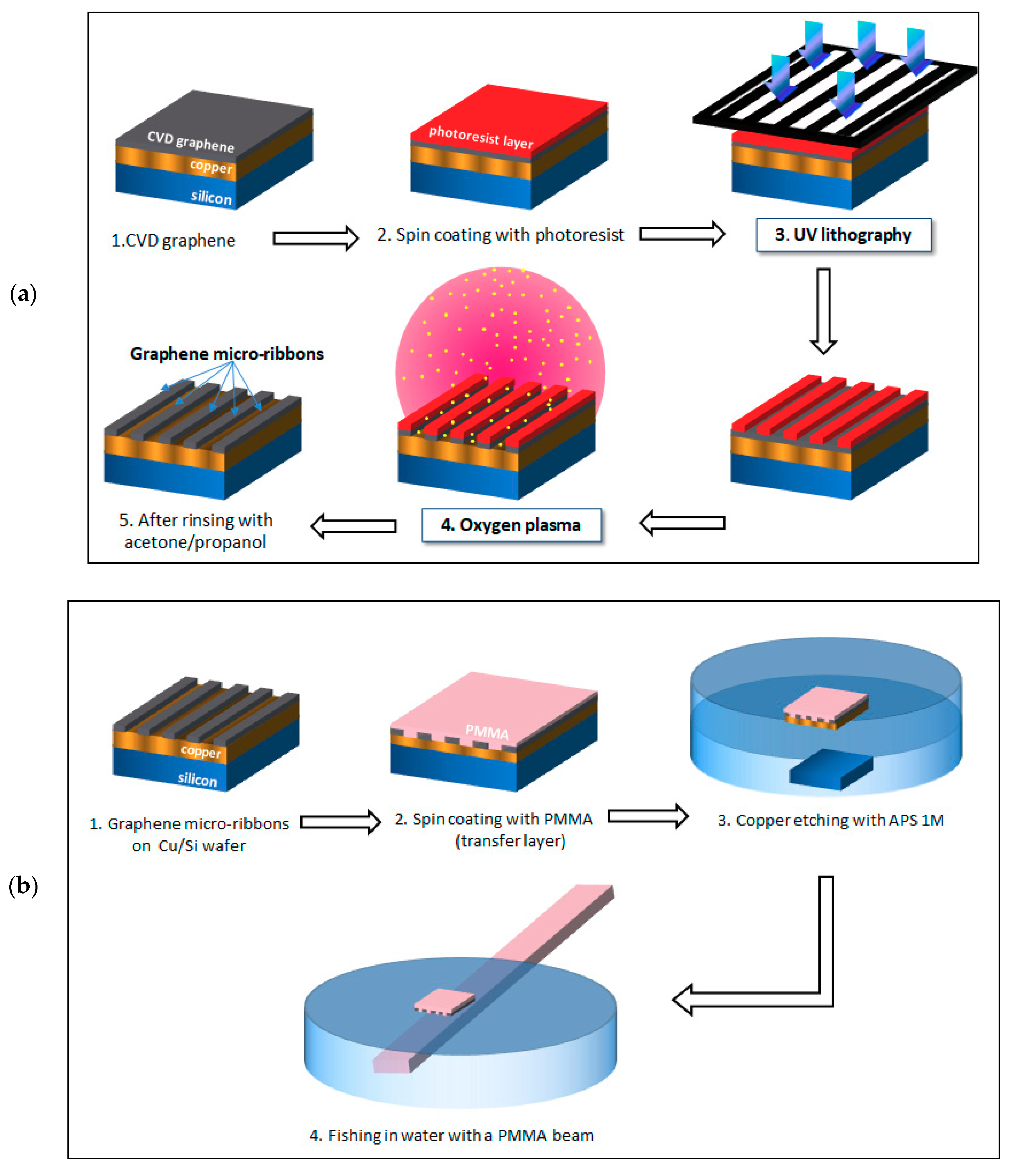
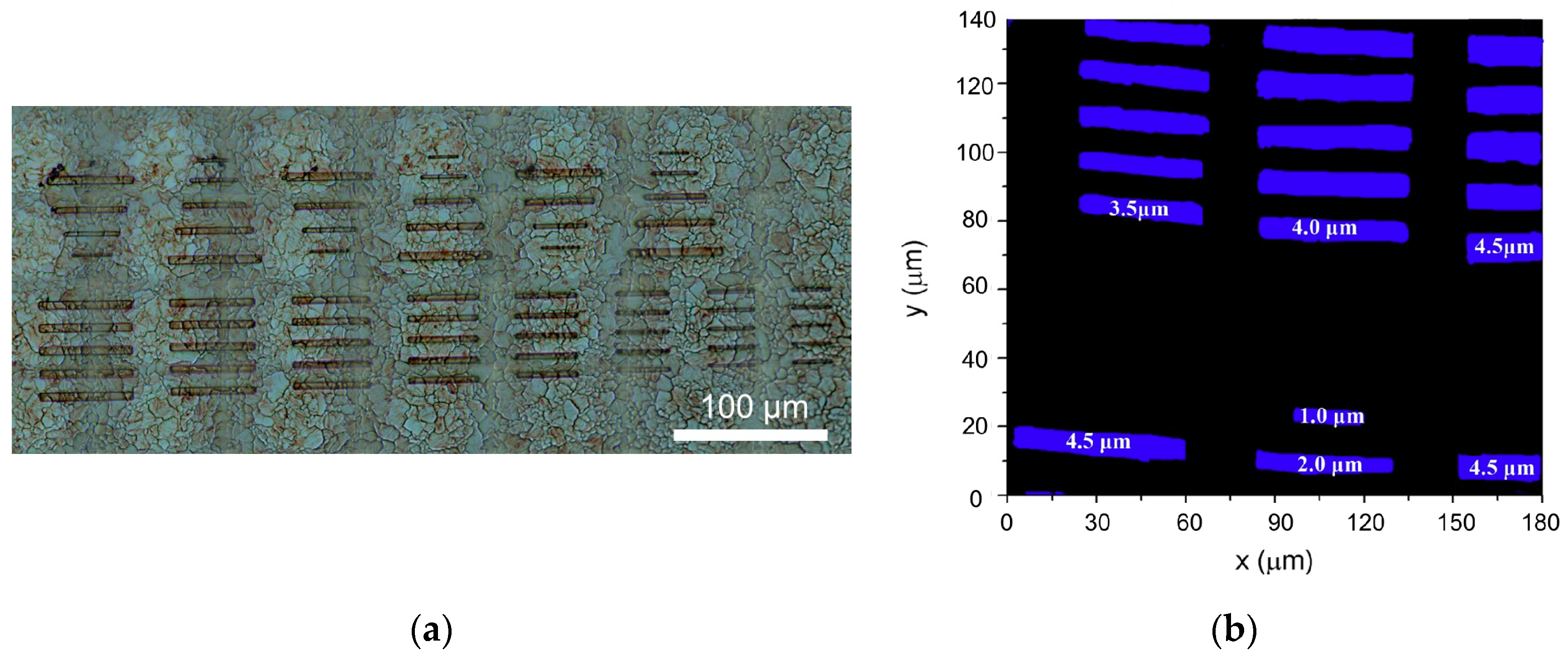
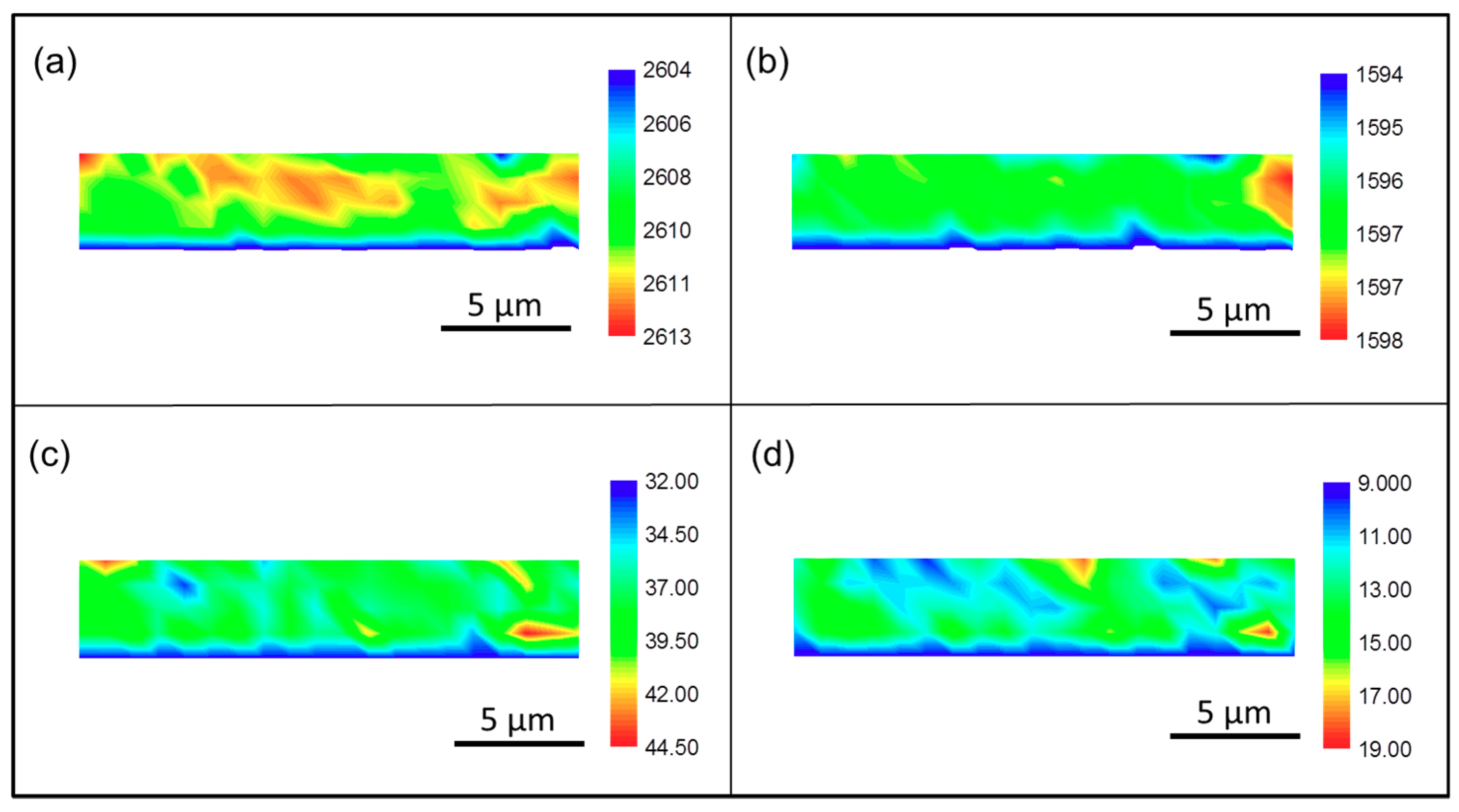

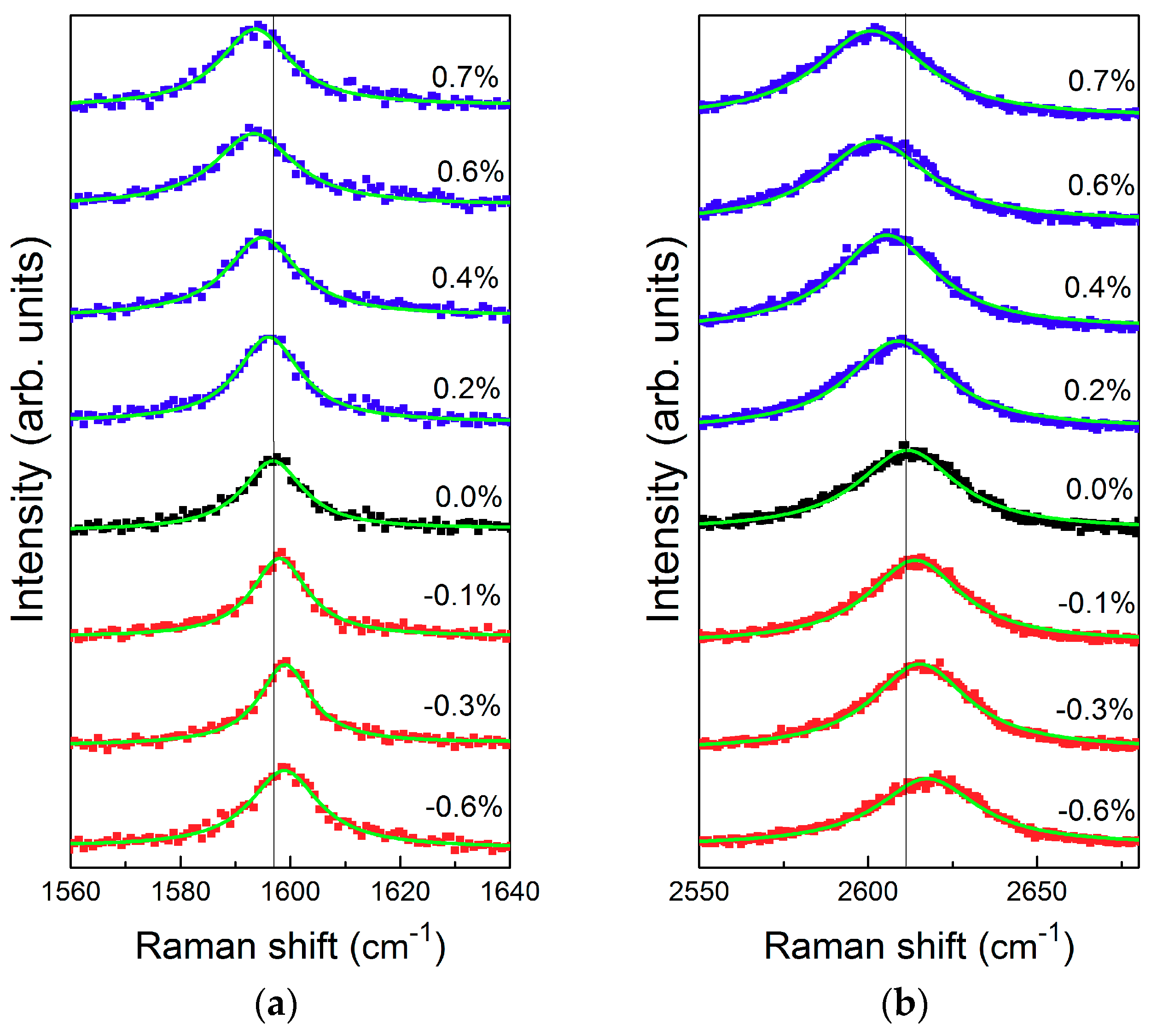
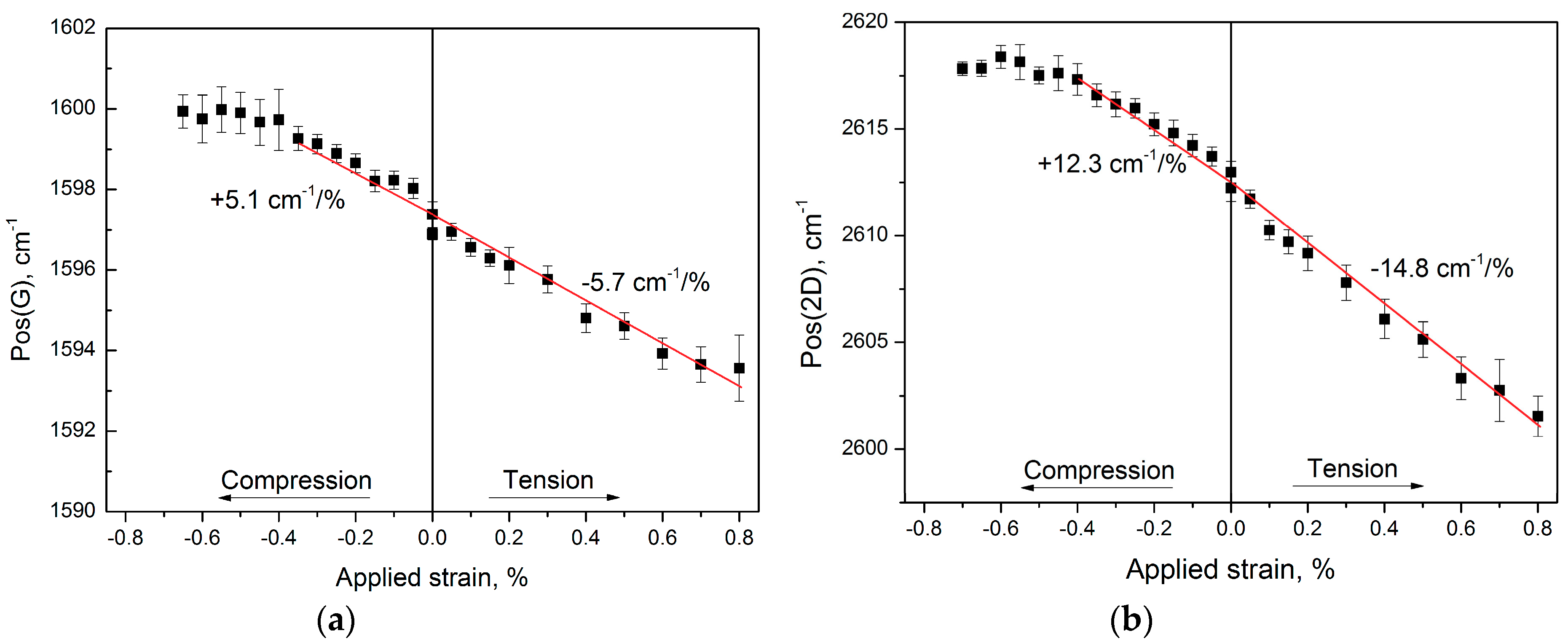
| Peak | Position (cm−1) | FWHM (cm−1) |
|---|---|---|
| G | 1596.2 ± 0.7 | 13 ± 2 |
| 2D | 2612 ± 1 | 38 ± 2 |
© 2019 by the authors. Licensee MDPI, Basel, Switzerland. This article is an open access article distributed under the terms and conditions of the Creative Commons Attribution (CC BY) license (http://creativecommons.org/licenses/by/4.0/).
Share and Cite
Pastore Carbone, M.G.; Tsoukleri, G.; Manikas, A.C.; Makarona, E.; Tsamis, C.; Galiotis, C. Production and Mechanical Characterization of Graphene Micro-Ribbons. J. Compos. Sci. 2019, 3, 42. https://doi.org/10.3390/jcs3020042
Pastore Carbone MG, Tsoukleri G, Manikas AC, Makarona E, Tsamis C, Galiotis C. Production and Mechanical Characterization of Graphene Micro-Ribbons. Journal of Composites Science. 2019; 3(2):42. https://doi.org/10.3390/jcs3020042
Chicago/Turabian StylePastore Carbone, Maria Giovanna, Georgia Tsoukleri, Anastasios C. Manikas, Eleni Makarona, Christos Tsamis, and Costas Galiotis. 2019. "Production and Mechanical Characterization of Graphene Micro-Ribbons" Journal of Composites Science 3, no. 2: 42. https://doi.org/10.3390/jcs3020042
APA StylePastore Carbone, M. G., Tsoukleri, G., Manikas, A. C., Makarona, E., Tsamis, C., & Galiotis, C. (2019). Production and Mechanical Characterization of Graphene Micro-Ribbons. Journal of Composites Science, 3(2), 42. https://doi.org/10.3390/jcs3020042








